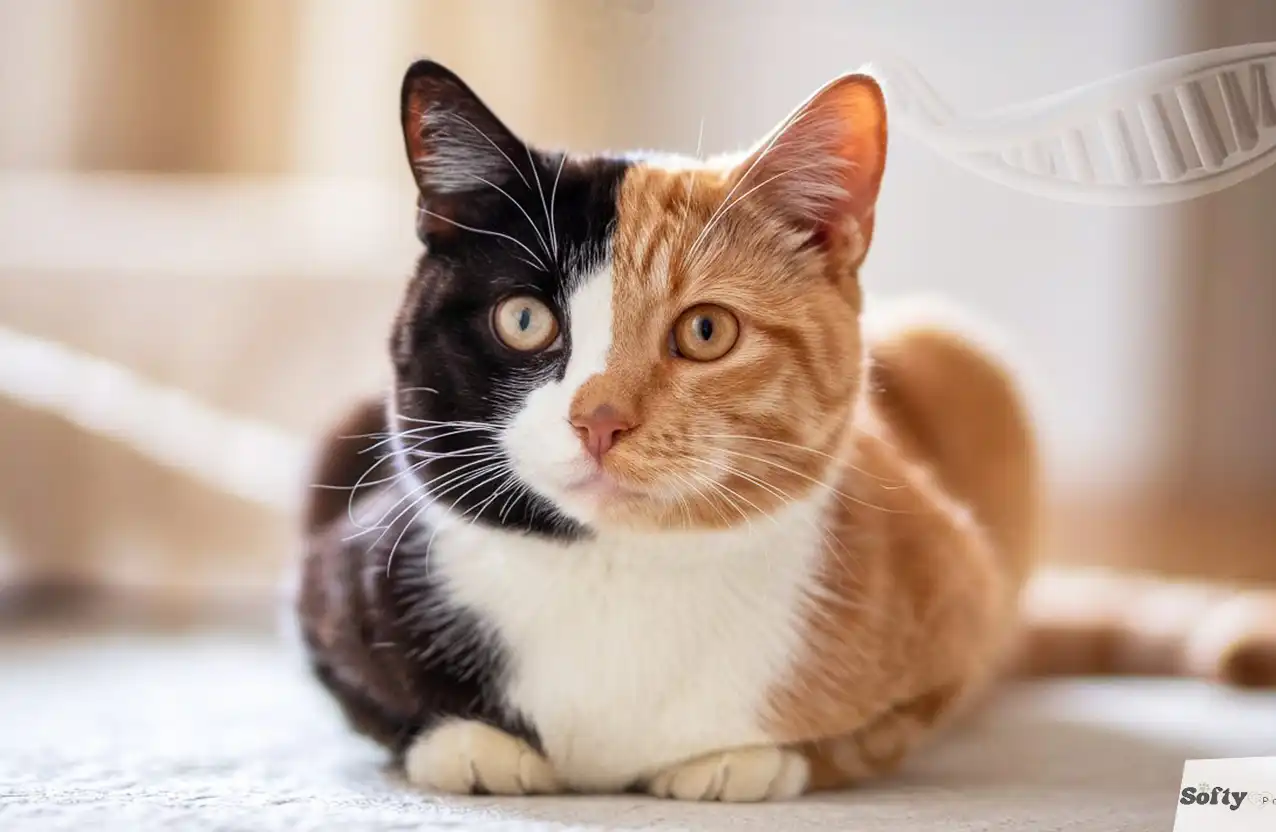When a Picture Looks Too Perfect
Every few months, someone tags me in a photo of a cat that looks split straight down the middle half jet-black, half orange, eyes two different colors.
I understand the doubt, a creature that seems half one cat and half another sounds more like something out of a fantasy novel than a litter box.
But the truth is both simpler and far more impressive: “yes, chimera cats are real”, though they’re much rarer and more complex than viral photos suggest.
Where the Legend Began ?
The name chimera comes from “Greek mythology”, describing a fire breathing hybrid of lion, goat, and serpent.
centuries later, scientists borrowed that word to describe living beings made from two sets of DNA.
So when modern cat lovers saw those striking half-and-half faces online, the old myth met modern genetics.
I still remember the first “chimera” photo that crossed my feed. I studied it for minutes, amazed that nature could paint so precisely. That curiosity pushed me to dig into the science behind the markings—and eventually meet cats that truly fit the description.
The Science Behind the Magic
In simple terms, a chimera cat is the result of two embryos merging very early in development.
instead of becoming twins, the cells blend and create one kitten carrying two distinct sets of DNA.
You could think of it as two kittens sharing one body before either ever takes its first breath.
this is why some chimera cats have that dramatic half-and-half face or mismatched eyes — their genetics literally differ from one side of the body to the other. Still, those striking looks don’t appear in every chimera, and not every cat with wild coloring is a true chimera.
It’s also important to separate chimerism from mosaicism. Mosaics come from a single embryo that mutates as it grows, while chimeras are a full fusion of two. Only a DNA test can tell for sure which is which.
Real Cats, Real Cases
The cat world got its first taste of chimera fame with Venus, the internet’s most famous “split-face” feline. Her photo spread across every social feed imaginable one side black, one side orange, one blue eye, one green. While scientists haven’t officially confirmed Venus’s genetics, she sparked global fascination with the idea of dual-DNA cats.
Since then, a few confirmed cases have made it into veterinary journals and genetic studies. One shelter cat showed two completely different DNA profiles when tested — proof of true chimerism. Another research case described an orange-and-gray cat with a perfectly divided coat, verified through lab analysis.
After decades of fostering, I’ve met maybe two cats that made me pause and think, “This could be the real thing.” That’s how rare they are and why every confirmed case feels like a small scientific miracle.
When Illusions Fool the Eye
Not every cat with a dramatic color split is a genetic marvel. Lighting, camera angles, and even smartphone filters can exaggerate a pattern until it looks like two cats stitched together. More often than not, those “chimera” photos flooding social media are actually calico or tortoiseshell cats, whose coats are created by X-chromosome inactivation a completely normal genetic process in female cats.
Even professionals can be fooled by a striking picture. I’ve learned to always ask, “Has this cat been seen under natural light?” or, “Has a DNA test confirmed it?” The eye loves symmetry, but nature often tricks us into seeing more than what’s there.
So, admire those photos just remember that only science can separate a rare genetic fusion from clever lighting and a good camera.
Jake’s Take: Science Makes the Wonder Better
i’ve always believed that understanding the science behind something doesn’t take away its magic, but it actually deepens it.
The fact that two tiny embryos can merge to create one perfectly healthy, uniquely patterned cat is incredible in its own right, you don’t need legends or filters to make that story beautiful.
whenever I meet a cat with unusual markings or eyes that don’t match, I can’t help smiling. It’s like seeing biology show off. Knowing the “why” behind the look just makes me appreciate it more. Nature doesn’t need our imagination to be spectacular—she already is.
So next time a striking feline crosses your feed, enjoy the mystery but celebrate the science. That’s where the real magic lives.
Quick Answers
Are chimera cats real?
Yes, true chimera cats exist, though they’re extremely rare, they’re the result of two embryos fusing before birth, giving the cat two distinct “DNA profiles”.
How do they form?
It happens naturally in the womb two embryos that would have become twins merge into one kitten.
Are all split face cats chimeras?
No, many calico and tortoiseshell cats have similar coats due to normal color genetics, not “chimerism”.
Do chimera cats need special care?
No, they’re just as healthy as any other cat, the dual “DNA” doesn’t affect temperament or wellbeing.
Can I test my cat?
Yes, mail-in DNA tests like “Basepaws” or Wisdom Panel can compare samples from different areas of your cat’s body to detect dual DNA markers.
Curious whether your cat might be a true chimera?
Read my detailed guide How to Tell If Your Cat Is a Chimera.
- Famous Chimera Cats on Instagram and TikTok - October 20, 2025
- Are Chimera Cats Real or a Myth? - October 19, 2025
- How to Tell If Your Cat Is a Chimera? Signs, Genetics & Testing - October 16, 2025
